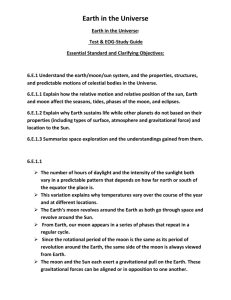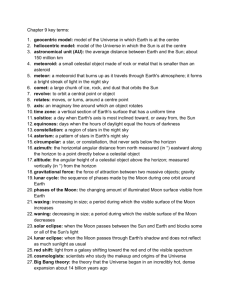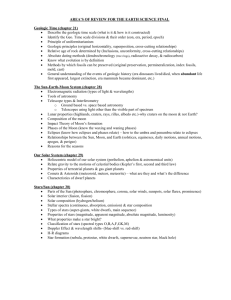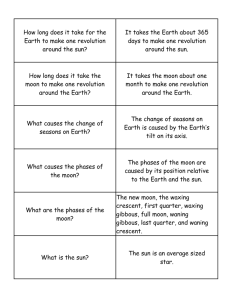The Earth in the Universe
advertisement
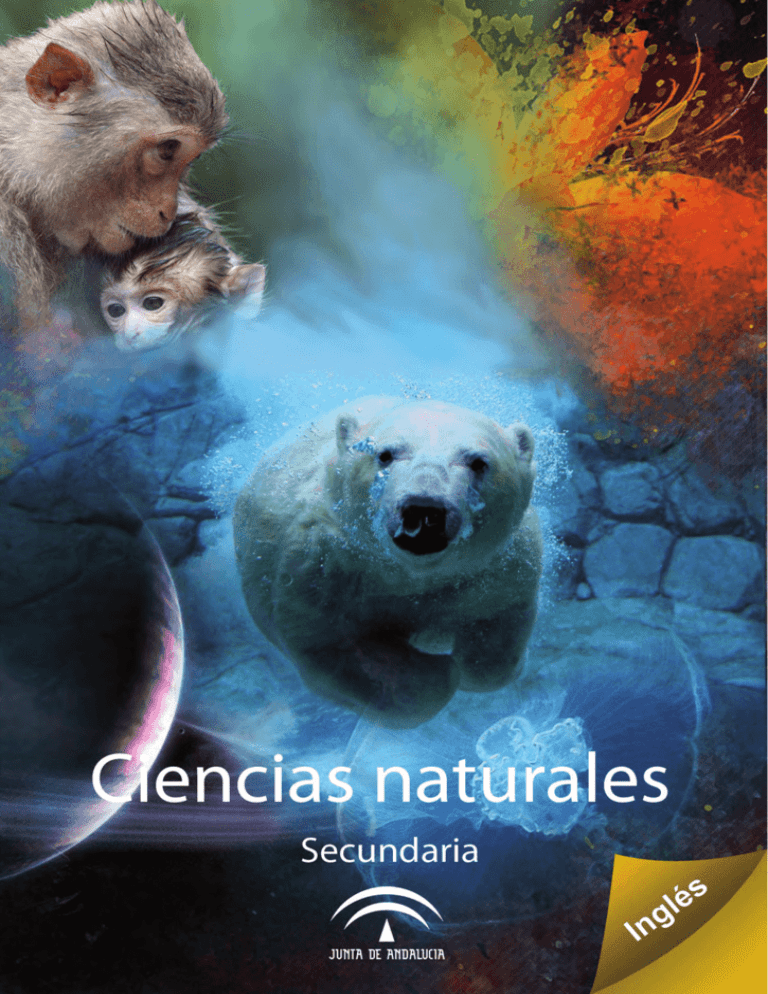
CONSEJERÍA DE EDUCACIÓN Dirección General de Participación e Innovación Educativa Identificación del material AICLE TÍTULO Earth in the Universe NIVEL LINGÜÍSTICO SEGÚN MCER A.2.1 IDIOMA Inglés ÁREA / MATERIA Ciencias Naturales NÚCLEO TEMÁTICO Bloque 2: La Tierra en el Universo. GUIÓN TEMÁTICO - El Universo tiene unas dimensiones extraordinarias y por ello es necesario el uso de unas unidades de medidas de longitud expresamente diseñadas para este ámbito - La Tierra forma parte del sistema solar siendo la Tierra sólo un planeta de otros que giran en torno al Sol - Nuestra vida en la Tierra está influenciado por la presencia del satélite Luna, que provoca eclipses y que vemos desde la Tierra de forma peculiar, siempre la misma cara y en diferentes fases FORMATO Material didáctico en formato PDF CORRESPONDENCIA CURRICULAR 1º de Educación Secundaria AUTORÍA Fernando Sánchez García TEMPORALIZACIÓN APROXIMADA 6 sesiones +2 para proyecto COMPETENCIAS BÁSICAS - Conocimiento e interacción con el medio físico. Con experiencias cercanas y observaciones simples directamente al cielo - Digital y tratamiento de la información. Mediante un recorrido por las diferentes informaciones aparecidas sobre informes científicos y estudios sobre los planetas, planetoides y eclipses, así como el uso de modelos del sistema solar así como del sistema Tierra-Luna - Social y ciudadana. A través de experiencias sencillas con materiales cercanos y de uso común para observación del cosmos que nos rodea. Así como el uso de convenciones internacionales en el establecimiento de zonas horarias etc. - Aprender a Aprender. Mediante la realización de conexiones conceptuales y modelos que se basan en la experiencia propia - La competencia de comunicación lingüística es una competencia tratada de forma continuada tanto en inglés como en español OBSERVACIONES - Esta secuencia didáctica es idónea para iniciar el curso y debería ser una pieza de conexión el área de Ciencias Sociales - La medida de grandes distancias con unidades especificas es un recurso para introducir la convencionalidad de las medidas realizadas y adaptándose al objeto de medida, lo cuál se refuerza con el uso de convenciones para establecer la hora oficial Material AICLE 1º de ESO: The Earth in the Universe 3 Tabla de programación AICLE OBJETIVOS - Interpretar y producir con propiedad, autonomía y creatividad mensajes que utilicen códigos artísticos, científicos y técnicos - Comprender los principios básicos que rigen el funcionamiento del medio físico y natural, valorar las repercusiones que sobre él tienen las actividades humanas y contribuir activamente a la defensa, conservación y mejora del mismo como elemento determinante de la calidad de vida CONTENIDOS DE CURSO / CICLO - El Universo, estrellas y galaxias, Sistema Solar - La Tierra como planeta. Los fenómenos naturales relacionados con el movimiento de los astros: estaciones, día y noche, eclipses - La Luna Satélite natural de la Tierra, y su participación en fenómenos naturales TEMA - Las distancias en el universo - El Sol y el sistema solar - El sistema Tierra-Luna - Movimientos de la Tierra y sus consecuencias - Fases lunares y eclipses MODELOS DISCURSIVOS - Describir situaciones provocado por los astros observadas en la vida diaria - Relacionar diferentes fenómenos planetarias que podrían tener una explicación basada en algo común - Discutir, argumentar y sintetizar las opiniones e ideas sobre fenómenos celestes - Explicar y dialogar con sobre los hechos experimentales observados y medidos TAREAS - Realización de mapas conceptuales en los que se relacionan los diversos conceptos - Preparar presentaciones para el resto de compañeros en formato digital o en papel - Exponer al resto de los compañeros los resultados de pequeñas investigaciones del entorno - Consensuar respuestas y conclusiones FUNCIONES: - Expresar distancias - Expresar disconformidad - Comparar espacios y horas CONTENIDOS LINGÜÍSTICOS ESTRUCTURAS: Did you find....? Look for information...... Complete this chart with Find this concept I agree I disagree Can you.. ? Refer to ...... By the way Have a look... In my opinion, this is right There is/are In order to Look around Instead of It could be If I understand On the other hand, I think ... Because of.... LÉXICO: light-year, U.A., planet, satellite, comets, asteroids, stars, galaxies., local-time, time zone, eastern,, westward, boundary, spring, summer, autumn, winter, move, movement, Mercury, Venus, Earth, Mars, Jupiter, Saturn, Uranus, Neptune, Pluto, Sun, Solar System, Milky way, Hemisphere, Equinox, Solstice, UTC, tie, tiebreak, CRITERIOS DE EVALUACIÓN 4 - Explicar el significado de unidad astronómica (UA) y año luz - Conocer la posición relativa de los distintos cuerpos que componen el sistema solar y, en especial, la del sistema Tierra-Luna - Describir la causa de la secuencia de las estaciones - Describir la causa por la que se pueden observar las fases lunares - Conocer por qué se producen las estaciones y los solsticios y equinoccios en ambos hemisferios terrestres - Comprender el mecanismo de formación de los eclipses Material AICLE 1º de ESO: The Earth in the Universe THE EARTH IN THE UNIVERSE I.- How do we measure distances in the Universe? Brainstorm Please observe the night sky and try to answer the questions using the words on the right: - What are the lights that we can see? - Are they all equally bright? - Are they all the same distance from the Earth? - What unit of measure is used to measure that distance? The lights are ................ Some of them are less bright than .............. I think the most apropriate unit of measure is .................... I don’t think all the lights ................................ I think I can see different sized lights because ................... The biggest ones might be ............................. Material AICLE 1º de ESO: The Earth in the Universe 5 A.1. a) Match the words and the explanations: 1 Planet a. Rocky bodies which are smaller than planets, irregular in shape, which orbit around the Sun 2 Comet b. A celestial body orbiting the Sun on a very long trajectory. 3 Asteroids c. A group of stars (ten or hundreds or thousands) eg. the Milky Way. 4 Star d. Approximately the mean distance between the Earth and the Sun. 5 Galaxy e. The distance covered by light in a year, (= 10 billion km). 6 Satellite f. Celestial body which continuously radiates energy into the space around it (eg. the Sun). 7 U.A. g. A celestial body orbiting a star (eg. the Earth). 8 Light-year h. A natural body that revolves around a planet (eg. the Moon). A.1 b) What’s the Difference? Planet - Comet Asteroid - Planet Planet -Satellite Star – Galaxy U.A – Light-year Star - Planet The most interesting difference between .......... and .............. is ...................... By the way, don’t forget that ................................... In my opinion you’re right but it’s more important to emphasize that ................... I think they are similar but with a little difference that is .......................... I agree with you, but I don’t think we need to write about it because it’s obvious that .......... I disagree with you because .......... 6 Material AICLE 1º de ESO: The Earth in the Universe A.2. Distances… Listening a) complete the chart b) answer the questions Astronomic distances from the Earth ObjectDistance Space station300 km Meteorological satellite The Moon384,000 km Pluto α Centauri 4 light years The Centre of the galaxy The galaxy Andromeda 2 million light years The farthest____________ ________________ light years Questions: - What is closest to Earth? - What is farthest from Earth? - The light from the Sun and the star α Centauri both come to the Earth. Imagine you are observing both and you can see the light from them. Which light arrived first? Why? In fact, if you have a look at the chart, the closest one is ................ Don’t confuse the units ................... and ............... they’re not the same I think the light from .......... arrives first because....................... Material AICLE 1º de ESO: The Earth in the Universe 7 II.- The solar System. Use the words above to label these photographs. Work with a partner. Compare your answers with the rest of the class. I think the photo in ............. line and.......... column is the planet ........................ That’s not a planet, it’s a star called .................... This object is too small to be a planet. I think it’s .................... In my opinion this is ..................................... I’ve just checked it on the internet and I discovered that ...................... 8 Material AICLE 1º de ESO: The Earth in the Universe Material AICLE 1º de ESO: The Earth in the Universe 9 2.1. How the Solar system is organised.(Refer to appendix I) A.3. Comets and Asteroids Skim the text and underline the key words. Now read the text again and check meaning. Then answer the questions below: Comets are described by astronomers as “dirty snowballs.” They have a nucleus of dust and ice surrounded by a coma (thin atmosphere of evaporated ice). The nucleus is mainly water (H2O), with some ammonia (NH), methane (CH), and carbon dioxide (CO). Comets have two tails: the ion tail is gas and blue, and the dust tail is yellow. Meteor showers, like the Perseid or Leonids, occur when the Earth travels through a comet’s dust tail. Comets come from the Oort Cloud or the Kuiper Belt. The Oort Cloud contains 1011 comets Asteroids, sometimes called minor planets or planetoids, are small Solar System bodies in orbit around the Sun, especially in the inner Solar System. They are smaller than planets but larger than meteoroids. You can tell the difference by looking at them: Comets have a perceptible coma while asteroids do not. The asteroid belt lies between the planets Mars and Jupiter. It contains lumps of rock and metal much smaller than planets. These lumps are called asteroids or minor planets. They are not visible from Earth to the naked eye, but many may be seen through binoculars or small telescopes. 10 Material AICLE 1º de ESO: The Earth in the Universe Comprehension questions: True or False? Why? a. The ion tail of a comet is made up of solid materials. b. The comets come from a place near the Earth. c. The asteroid Ceres is in the outer Solar system. d. You can see asteroids on a clear night to the naked eye (no telescope or binoculars). Compare your answers with the rest of the class. Justify your opinion: In my opinion this is True/False because in the text ........................ I disagree……. But look where it says………… In fact, it depends on .................................... A.4. Planets flashcards. We are going to make some flashcards to help us remember about the planets. Layout: Front: A photo of planets, sun or asteroids. Back: The name of the planet, sun or asteroids. Plus additional information like factoids1 or data like distance from the Sun, radius, Solar revolution, average day length, number of moons, etc.... Procedure: In pairs: a. Look for photos of the planets and asteroids here: http://commons.wikimedia. org/wiki/Main_Page b. Look for information about the planets and asteroids here: http://en.wikipedia.org/wiki/Main_Page 1 A factoid is a questionable —unverified, incorrect, or fabricated—statement presented as a fact, but with no veracity. Material AICLE 1º de ESO: The Earth in the Universe 11 Example of flash card: Front: Back: SUN. What a big star! Avg. distance form Earth: 150 million km Radius (Equatorial): 109 x Earth Average day: 609 hours Temperature avg. : 5540 ºC Number of planets: 8 Planets and 3 dwarf planets 12 Material AICLE 1º de ESO: The Factoids: Our Sun is one of the millions of the stars in the Milky Way. It is the closest star to the Earth. 1,300,000 Earths could fit inside the Sun. The Sun is made of helium and hydrogen. Solar flares (sudden eruptions from the surface of the Sun) release energies that equal millions of hydrogen bombs Earth in the Universe A.5. THE BLUE SPHERE WE CALL HOME How big is the Sun and how far away? 1.Draw a circle with a diameter of 4 mm on a piece of paper. This is the Earth. 2.Draw a circle with a diameter of 44 cm on another piece of paper. This is the Sun. 3.Work in pairs. One is the Sun, one is the Earth. The Sun needs to be 50m from the Earth. 4.Now you can see the relationship in size distance between the Earth and the Sun. and Material AICLE 1º de ESO: The Earth in the Universe 13 III.- The Earth-Moon system. Brainstorm On EARTH: What causes day and night? Why are summer days longer than winter days? How come it’s winter in South Africa when it’s summer here? Why are there seasons? Why is it colder in winter than in summer. Is the sun moving? Why? How does the Moon change? How long is the lunar cycle? In my opinion ............................... Different seasons are due to .................... I think that something is moving, it is ........................................ I can’t believe that the sun doesn’t move because........................ Everybody tells me that seasons are due to ..................................... I agree because..................................... I’ve observed the moon and I think that ........................... On the other hand maybe ......................... 14 Material AICLE 1º de ESO: The Earth in the Universe 3.1. The Earth moves. The Earth moves in two different ways: 1. Rotation consists of the Earth turning on its own axis. The Earth takes 24 hours to complete a full circle. a) Note that the axis of rotation is slanted2 with respect to the plane of movement around the sun. This inclination has i mportant consequences for our planet. b) Consequences of rotation: i) Day and night. The Sun lights up one part of the Earth so that in some areas it is midday while in others it is sunset and in other it is the middle of the night. ii) Time zones: Rotation means we need standardized time zones. There are 24,one for each hour of the earth’s rotation. 2. Revolution consists of the Earth revolving around the Sun. The Earth takes 365 and a quarter days to complete one full journey around the Sun. a) Consequences of revolution + inclination on the axis. i) The seasons are marked by changes in the intensity of sunlight that reaches3 the Earth’s surface. ii) The Northern and Southern hemispheres have different seasons. In the North-ern hemisphere the seasons change on the following days: (1) Winter solstice: 21st or 22nd of December is the beginning of winter. 2 In between perpendicular and horizontal 3 To arrive somewhere Material AICLE 1º de ESO: The Earth in the Universe 15 (2) Spring equinox: 20th or 21st of March is the beginning of spring. (3) Summer solstice: 21st of June is the beginning of summer. (4) Autumn equinox: 22nd or 23rd of September is the beginning of autumn. Note: The difference between the temperatures during the summer and the winter is caused by the inclination on the axis or rotation and not by the distance between the Sun and the Earth. The seasons in the Northern and Southern hemispheres are different the same reason. 16 Material AICLE 1º de ESO: The Earth in the Universe A.6. A simple model. What causes day and night? Materials you need: a. A globe to represent the Earth b. A torch to represent the sun. Procedure a. Spin the ‘earth’ to demonstrate the change from day to night. One full turn takes 24 hours (1 day). b. Move the ‘earth’ around the ‘sun’ to demonstrate how the seasons come about. This takes 365¼ days (1 year). Final activity: Use the following key words to describe how day and night occur. Key words: earth, revolve, 24 hours, axis, sun, day, night A.6. Time Zones. You are going to listwen to someone talking about time zones, but first find some of the key words in the wordsearch: BOUNDARY CONVENTION COORDINATED DECREASE EARTH EASTERN LOCAL-TIME LOCATION MANDATED WESTWARD Did you find ...................... Can you help me with ......................, I can’t find it. Material AICLE 1º de ESO: The Earth in the Universe 17 A time zone4 is a region on ___________, more or less bounded by lines of longitude that has a uniform, legally___________ standard time, usually referred to as the_____________. By _____________, the 24 main time zones on Earth compute their local time as an offset from UTC (______________ Universal Time5). Local time in each time zone is UTC plus the current time zone offset for the _____________ in question. In theory, the increase proceeds eastward from the ____________ boundary of the UTC time zone centred on 0°, increasing by one hour for each 15°, up to the International Date Line (longitude 180°). A corresponding one hour____________ relative to UTC occurs every 15° heading __________ from the western_____________ of the UTC time zone, up to the International Date Line Look at the copy of the Time Zones (appendix 2). Now answer the following questions. Work with a partner. 1.My friend Freddy is in London; my watch says 7:00, what time does Freddy’s watch say? 2.I’m chatting with my friend Noemi who is in Guatemala. Is it day or night there? Why? 3.You’re going to fly from Madrid to New York. The flight leaves at 15:00. The trip takes nine hours. What time will it be in New York when you arrive? 4 Additional information in: http://www.24timezones.com/ 5 time standard based on International Atomic Time 18 Material AICLE 1º de ESO: The Earth in the Universe A.7. Complete the chart: Observable phenomenaCauses Days and nights Seasons b. What season is it in the Southern Hemisphere when it is summer in the Northern Hemisphere? Illustrate your answer with a drawing showing the Sun’s rays. Material AICLE 1º de ESO: The Earth in the Universe 19 3.2 The Moon: The Earth´s natural satellite. 1. Characteristics: a) Diameter: ¼ the Earth b) Distance from the Earth: 384,000 km. c) Doesn’t make its own light, only reflects Sun-light 2. Movements: a) Around the Earth. (Anti-clockwise orbit): i) 27.3 days. b) Around its axis. i) 29.5 days. 3. Consequences: a) The Dark side of the Moon: The moon rotates on its axis once in the same time it takes to orbit us once. This is the synchronous rotation of the Moon, so we always see the same face of the moon. b) Lunar Phases: The part of the moon which is illuminated by the Sun changes according to the position of both bodies and the Earth. i) Full Moon: the sun lights up the front of the Moon. ii) Waning Moon: the sun lights up one side of the Moon until it moves iii) New Moon: the dark side is lit up. iv) Waxing Moon: The sun lights up one side of the Moon again. c) Eclipses. i) Solar Eclipses: The Moon passes between the Sun and the Earth. The shadow of the moon is projected onto the Earth. (1) Total Eclipses: The Moon completely covers the Sun, so some part of the Earth is in total darkness. 20 Material AICLE 1º de ESO: The Earth in the Universe (2) Partial Eclipses. The Moon does not completely cover the full circle of the Sun. ii) Lunar eclipses. The Earth passes between the Sun and the Moon. The shadow of the Earth is projected onto the moon and completely or partially covers it. A.8. Revision a. Crossword: Across 2. Ways in which we see the Moon during a month. 4. The Earth takes 365 ¼ days to complete it 5. The Moon takes 27.3 days to move around it 6. It occurs when either the Moon or the Sun are in the shade. 7. Earth’s natural satellite. Down 1. They occur because of the Earth’s rotation axis inclination 3. The moon takes 29.5 days to move around it 4. When the Earth moves around its axis Can you help me with the word in ................................. I think the first letter is .............................. What do you think …………………… is? Do you know what the first letter of …………………………. is? How do you spell …………………………..? Material AICLE 1º de ESO: The Earth in the Universe 21 C-map: Fill in the gaps. Note: A C-map has concepts and “linking words” that are very important too, so both concepts and linkers are important in order to make whole sentences when you follow a path in the map. What linker can we write between ....................... and .................? In my opinion the appropiate concept here is ............... because..................... I agree with you but maybe …………………. I disagree, I think this is wrong. This refers to ............... 22 Material AICLE 1º de ESO: The Earth in the Universe Project: Quiz show. We’re going to play Jeopardy. This is a quiz where you are given the answer and you have to say what the question was. A Preparing the cards for the quiz. 1. The class will be divided into 4 groups, each one will write sixteen answers (and questions) r elated to the following categories: a) Distances in the Universe. b) Solar System c) Movement of the Earth and consequences d) Movement of the Moon and Eclipses. 2. The Answer-questions must be written down on cards. The teacher must keep the cards in a box until the quiz starts. a) Levels of Difficulty we need: i) 4 very easy (score 2 points) ii) 4 easy (score 4 points) iii) 4 quite difficult (score 6 points) iv) 4 difficult (score 8 points) b) Use the internet to help you. c) Write your questions in the boxes below. Very Easy Easy Soft Difficult Difficult Material AICLE 1º de ESO: The Earth in the Universe 23 B.- Quiz Development. 1. There are 4 rounds, one for each category. 2. Each round involves 4 groups: (The presenter is the teacher) a) 3 Contestant groups. b) 1 Rebound group. (The group who wrote the questions) i) E.g. If the category 1 answers are used for Round 1, the group that wrote the cards for this category is the rebound group while the rest are contestant groups. 3. The quiz starts when one of the constestant groups chooses one of the 16 cards for this category (remember! depending on the difficulty, they score different). a) You have 5 seconds to say the question. i) If the response is correct (according to the one written on the card), the group scores the total points for the card. ii) If the response is not correct, the rebound group has a chance to give a res ponse: (1) If the response is correct, the rebound group scores half of the points. (2) If the response is not correct, the points are subtracted from the rebound group score. b) The next contestant chooses another card and the procces continues, until all the cards have been used. 4. A new round starts again with a new category and a new rebound group. 5. The winners will be the group with the best score. 6. If there is a tie, a tiebreak round will be played with cards written by the teachers. Good Luck! 24 Material AICLE 1º de ESO: The Earth in the Universe What I have learned. (Self assessment) - I can understand what a UA is and I can use it to measure distances. - I can understand what a light-year is and I can use it to measure distances. - I can distinguish the different components of the solar system - I can find the planets and dwarf planets on a stellar map. - I can explain why seasons occur. - I can explain how night becomes day (and vice versa). - I can explain how the Lunar phases occur. - I can explain what an eclipse is. - I can distinguish between a solar eclipse and a lunar eclipse. Material AICLE 1º de ESO: The Earth in the Universe 25
